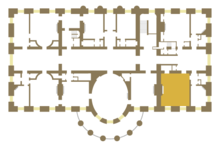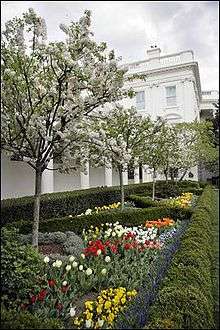Lincoln Bedroom

The Lincoln Bedroom is located in the southeast corner of the second floor of the White House, part of a guest suite that includes the Lincoln Sitting Room. The rooms are named for Abraham Lincoln, and the room that was in this location—before the extensive 1948–1952 renovation—was used by President Lincoln as an office.[1]
From 1929 until the Truman renovation, the room in the northwest corner of the White House—now used as a Family Residence Dining Room—was known as the Lincoln Bedroom and contained the Lincoln bed, and Lincoln family photographs.[2]
Furnishings

The room has been furnished in a mix of Victorian styles including Renaissance Revival, Rococo Revival, and Aesthetic Movement, since the Truman renovation. Some of the furniture was used by the Lincoln administration but was purchased during earlier administrations, including the sofa and three matching chairs, two slipper chairs, and four of Lincoln's cabinet chairs. The central feature of the room is the Lincoln bed, a nearly eight-foot by six-foot rosewood bed with an enormous headboard which is believed to have been purchased by Mary Todd Lincoln during her extensive redecorating efforts. The bed was probably never used by President Lincoln, although several later presidents have used it. An ornamental crown-shaped canopy hood was recently reconstructed to replace the lost original.
A holograph copy of the Gettysburg Address is displayed on the desk. This copy is the only one of five that is signed, dated, and titled by Lincoln.
History
Before the construction of the West Wing in 1902, the current Lincoln Bedroom was used as either an office or a meeting room for the president's Cabinet. When the president's staff was moved to the new West Wing, this room became a bedroom suite called the "Blue Bedroom." When the White House was gutted and rebuilt during the Truman administration, these southeast corner rooms were rebuilt and dedicated to Abraham Lincoln.
The room has been redecorated several times in the past half century, most notably by Jackie Kennedy, but always including furnishings from the Victorian period.
When Abraham Lincoln was president, the southeast corner suite was used as his personal office and Cabinet room (it was used in this manner by all presidents between 1830 and 1902). During the Lincoln presidency, the walls were covered with Civil War maps. It had dark green wallpaper, and the carpeting was also dark green. Newspapers were stacked on the desk and tables along with large amounts of mail and requests from office seekers. Two large wicker wastebaskets were filled with debris.
President Lincoln signed the Emancipation Proclamation in this southeast suite on January 1, 1863.
Assessment during the Clinton administration
During the Clinton administration the Committee for the Preservation of the White House and then Curator of the White House Betty Monkman began initial assessment for the refurbishment of the room. While most of the furniture and artwork in the room was found to be of similar related periods, and much was associated with the presidency of Lincoln, the room's carpeting, mantel and anemic painted walls were not of the period. Initial decisions were made to replace the existing Neoclassical mantel with a mid-19th-century style mantel design, and to use more pattern as would have been used in Lincoln's day for the wallpaper and carpet. Two etchings and a drawing consistently showed a diamond patterned wallpaper and a Renaissance Revival style gas chandelier. A small oil painting showed a color representation of the same diamond patterned wall paper in dark green, mustard and teal.
Redecoration during the George W. Bush administration
During the administration of George W. Bush the new curator, William Allman along with new Bush appointees to the Committee for the Preservation of the White House, including Bush family decorator Ken Blasingame, continued with the process. A boldly patterned Renaissance Revival patterned carpet was created for the room. The wallpaper became a compromise, using the diamond pattern found in the historic engravings and painting, but eschewing the deep Victorian color palette found in the oil painting, for a much lighter off-white color favored by the Bush family in many of the White House rooms they refurbished.
The crown-shaped canopy hood which originally held the canopy of the Lincoln bed was recreated, and the lace and silk and wool velvet bed drapes were accurately recreated, including hand-made fringe and tassels based upon 19th-century photographs. New gilded window valances in the Rococo Revival style, perhaps intended to echo the bed canopy crown were created in place of those shown in engravings, drawings and a painting made during Lincoln's presidency.
See also
References
- ↑ "Truman Reconstruction : 1948–1952". The White House Museum.
- ↑ "Family Residence Dining Room". The White House Museum.
Further reading
- Time: "The Origins of the Lincoln Bedroom"
- Washington Post: "Lincoln Bedroom's Sleepy Look to Get A Wake-Up Call"
- CNN: "(Bill) Clinton Ok'd Using Lincoln Bedroom For Contributors"
- Common Dreams: "(George W.) Bush Fund-Raisers Among Overnight Guests in the Lincoln Bedroom"
- ("He Just Does What He Thinks Is Right")
External links
| Wikimedia Commons has media related to Lincoln Bedroom. |
- White House Historical Association: The Lincoln Bed
- White House Museum: The Lincoln Bedroom
- Lincoln Bedroom
Coordinates: 38°53′51″N 77°02′11″W / 38.897617°N 77.036363°W


